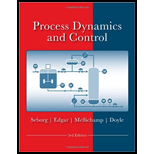
Interpretation:
For the third-order system, it is to be shown that its ramp response lags behind the input signal by three times constant as the output starts changing linearly with time for
Concept introduction:
For chemical processes, dynamic models consisting ordinary differential equations are derived through unsteady-state conservation laws. These laws generally include mass and energy balances.
The process models generally include algebraic relationships which commence from
For a function
Here,
The difference in the actual variable
In steady-state process, the accumulation in the process is taken as zero.
Want to see the full answer?
Check out a sample textbook solution
Chapter 5 Solutions
Process Dynamics and Control, 4e
- Problem 1. For an irreversible liquid phase reaction 2A -> B, the reaction rate is of the 2nd order with respect to the reactant concentration CA. The concentration-dependent reaction rate is plotted below. This reaction is performed in a cascade of two identical CSTRS (same reactor size and temperature). The inlet concentration of A of the 1st CSTR is 2 mol/L. The outlet concentration of A of the 2nd CSTR is 1 mol/L. The inlet flow rate of the 1st reactor is 100 L/h. Please use the graphical method to determine the outlet concentration of A of the first CSTR and the size of each CSTR. Please briefly show the procedure for reactor size calculation. (-4-7) 15225050 45 40 35 30 0 0.5 11.761.5 C₂ Q C (mol.L¹) Co 20 2.5arrow_forward15.15 A 0.20-m-thick brick wall (k = 1.3 W/m K) separates the combustion zone of a furnace from its surroundings at 25°C. For an outside wall surface temperature of 100°C, with a convective heat-transfer coefficient of 18 W/m² K, what will be the inside wall surface temperature at steady-state conditions? .arrow_forwardAn MF membrane has pore-size distribution as follows: d(pore)0.33 fraction¼ 1.5 mm, d(pore)0.33 fraction¼ 1.0 mm, and d(pore)0.33 fraction¼ 0.5 mm. Required (a) Determine the distribution of flux density for each pore size. (b) Show by a plot the distribution of pore sizes and the distribution of flux density. solvearrow_forward
- A gas pipeline, NPS 20 with 0.500 in. wall thickness, transports natural gas (specific gravity = 0.6) at a flow rate of 250 MMSCFD at an inlet temperature of 60°F. Assuming isothermal flow, calculate the velocity of gas at the inlet and outlet of the pipe if the inlet pressure is 1000 psig and the outlet pressure is 850 psig. The base pressure and base temperature are 14.7 psia and 60°F, respectively. Assume compressibility factor Z = 1.00. What is the erosional velocity for this pipeline based on the above data and a compressibility factor Z = 0.90?arrow_forwardH.W.1 : The elementary liquid phase reaction A + BR + S is conducted in a setup consisting of a mixed reactor, into which two reactant solutions are introduced, followed by a plug flow reactor. The component B is used in a large excess so that the reaction is first order with respect to A. Various ways to increase the production rate are suggested, one of which is to reverse the order of these units. How would this change/affect conversion?arrow_forwardH.W.2 : The kinetics of the liquid phase decomposition of A is studied in two mixed flow reactors in series, the second unit having twice the volume of the first one. At steady state with a feed with CA, = 1 mol/l and mean residence time of 96 s in the first reactor, the concentration of A in the first unit (reactor) is 0.5 mol/l and in the second is 0.25 mol/l. Find the rate equation for the decomposition of A.arrow_forward
- A natural gas consists of the following molar composition: C1 = 0.871, C2 0.084, C3 = 0.023, CO2 = 0.016 and H2S = 0.006. Calculate the gas gravity to airarrow_forward8 9:07 D Asiacell من تدوير العجلة. إستمر في إستخدام تطبیق آسياسيل للحصول على المزيد من العروض المميزة! الأحد، ١٦ مارس إنتهت صلاحية الإنترنت التي تلقيتها من تدوير العجلة. إستمر في إستخدام تطبیق آسياسيل للحصول على المزيد من العروض المميزة! الاثنين، ۱۷ مارس 1000 د ارسلت من ر رصيدك الى 7707268140 في 2025/03/17. 350 د تم إستقطاعها من رصيدك لهذه العملية 8000 د ارسلت من رصيدك الى 7707268140 في 2025/03/17. 350 د تم إستقطاعها من رصيدك لهذه العملية Vol) Voi) ٨:٥٤ ص ٢:١٤ ص ٩:٥٢ م 29:07 III =arrow_forwardPGE508 Assignment 2 A mixture with 4% n-pentane, 40% n-hexane, 50% n-heptane, and 6% n-octane is to be distilled at 14.7 lb/in² (1 atm.) with 98% of the hexane and 1% of the heptane recovered in the distillate. If the liquid feed is a saturated liquid (i.e., q= 1). Calculate i.) The product compositions, ii.) The top and bottom temperature iii.) Minimum reflux ratio (Rm), iv.) Minimum theoretical plates and v.) Actual plates when the reflux ratio is 2Rm. Table 1: Component boiling point and molar mass Component Boiling point n-C5 97°F n-C 156.2°F n-C 209.1°F n-C8 258.1°F Molar mass 72.2 86.2 100.2 114.2 Hint: Since 1% of heptane is specified to be recovered in the distillate, 99% of heptane is to be recovered in the bottom.arrow_forward
 Introduction to Chemical Engineering Thermodynami...Chemical EngineeringISBN:9781259696527Author:J.M. Smith Termodinamica en ingenieria quimica, Hendrick C Van Ness, Michael Abbott, Mark SwihartPublisher:McGraw-Hill Education
Introduction to Chemical Engineering Thermodynami...Chemical EngineeringISBN:9781259696527Author:J.M. Smith Termodinamica en ingenieria quimica, Hendrick C Van Ness, Michael Abbott, Mark SwihartPublisher:McGraw-Hill Education Elementary Principles of Chemical Processes, Bind...Chemical EngineeringISBN:9781118431221Author:Richard M. Felder, Ronald W. Rousseau, Lisa G. BullardPublisher:WILEY
Elementary Principles of Chemical Processes, Bind...Chemical EngineeringISBN:9781118431221Author:Richard M. Felder, Ronald W. Rousseau, Lisa G. BullardPublisher:WILEY Elements of Chemical Reaction Engineering (5th Ed...Chemical EngineeringISBN:9780133887518Author:H. Scott FoglerPublisher:Prentice Hall
Elements of Chemical Reaction Engineering (5th Ed...Chemical EngineeringISBN:9780133887518Author:H. Scott FoglerPublisher:Prentice Hall
 Industrial Plastics: Theory and ApplicationsChemical EngineeringISBN:9781285061238Author:Lokensgard, ErikPublisher:Delmar Cengage Learning
Industrial Plastics: Theory and ApplicationsChemical EngineeringISBN:9781285061238Author:Lokensgard, ErikPublisher:Delmar Cengage Learning Unit Operations of Chemical EngineeringChemical EngineeringISBN:9780072848236Author:Warren McCabe, Julian C. Smith, Peter HarriottPublisher:McGraw-Hill Companies, The
Unit Operations of Chemical EngineeringChemical EngineeringISBN:9780072848236Author:Warren McCabe, Julian C. Smith, Peter HarriottPublisher:McGraw-Hill Companies, The





